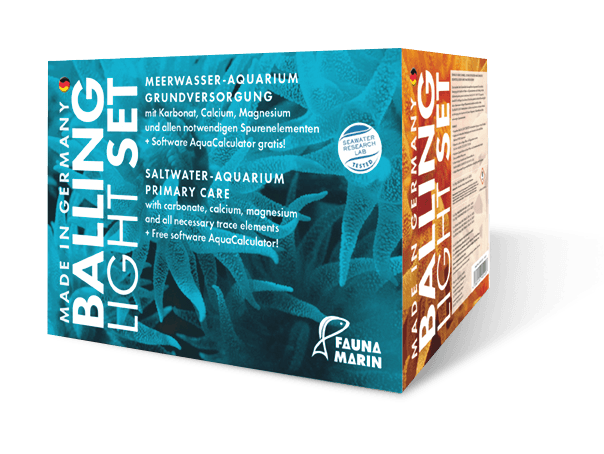Magnesium
As already mentioned under the keyword carbonate hardness, magnesium, in simple terms, is the safeguarding of the chemical composition for the calcium in saltwater. Magnesium is important for growth in various animal marine organisms and corallin algae.
What’s this:
Magnesium is a macroelement and part of the calcium supply system or salinity line in saltwater. Although magnesium is not used as frequently as calcium and carbonates, a stable calcium value is not possible without magnesium. Some living creatures such as corallin algae, clams or sea urchins absorb larger amounts of magnesium.
Problems:
High magnesium concentrations are still acceptable up to a value of approx. 1.600 mg/l (0,26 US.liq.gal.). Higher values cause a chemical imbalance in the supply of calcium, lead to tissue dissolution in soft corals and tissue detachment in SPS corals. For algae control, it is repeatedly recommended to increase the magnesium concentration to values above 1.800 mg/l (0,26 US.liq.gal.), but we strongly advise against this. Too low values (below 1.100 mg/l (0,26 US.liq.gal.)) destabilize calcium and carbonate hardness values, cause coral bleaching and tissue detachment in LPS corals from the base.
Measures:
Regular control of the Mg value, observance of the salinity line, partial water change with Fauna Marin Professional Sea Salt as well as dosing via Elementals Mg.
Indicator species:
Ring-shaped dissolving of coralin algae, lack of polyp expansion in soft corals, poor growth of clams and gorgonians.
Value too high:
Reduce the addition dosage, partial water change, avoid values above 1.600 mg/l (0,26 US.liq.gal.).
Value too low:
Supplement Elementals MG.
| Variety | Alkali metal |
|---|---|
| Benefit | 1.200–1.350 mg/l (0,26 US.liq.gal.) |
| Skill Level | Green |
| Source | salt, supply systems, trace element mixtures, salt mixtures, substrate, decoration |
| Available | Elementals MG, Balling-Light-System, Feed |
| Importance 1–6 | 2 |
| Detection quality | safe |
| Relation values | Salinity, Calcium, Alkalinity |

Balling Light:
If values are too low, supplement with from canister 2 and adjust dosing accoringly (increase or reduce MG by 10 %). If the Balling light method is carried out with regular partial water changes with Professional Sea Salt, usually no magnesium dosage is required.
Magnesium
If values are too low, supplement with from canister 2 and adjust dosing accoringly (increase or reduce MG by 10 %). If the Balling light method is carried out with regular partial water changes with Professional Sea Salt, usually no magnesium dosage is required.
Magnesium has the important function of inhibiting calcification in aquaria. The solubility of calcium in seawater is increased by preventing the formation of calcite (calcium carbonate, insoluble), i.e. magnesium keeps calcium in solution longer so that it does not precipitate. Slight fluctuations in the magnesium value do not have a major effect. Nevertheless, fluctuations should be avoided, as high values cause precipitation in the aquarium system and unnecessarily lead to high carbonate consumption. The precipitates are reflected on the rock decoration and the substrate. They bind further elements and phosphates to the decoration and thus intensify the depot effects. Since the magnesium consumption is so different from one tank to another, it should be dosed according to consumption. Especially too high or wrongly adjusted magnesium concentrations cause unnaturally high carbonate or calcium consumption. Pay attention to our salinity line and adjust the dosages accordingly. Interestingly, the magnesium value in particular is repeatedly misinterpreted. Even a few percent deviation then appears as if it were a large amount. Due to the high proportion of magnesium in seawater, a 20–30 mg fluctuation is no big deal.
Too low magnesium concentrations can be detected by ring-shaped brightening in corallin algae, but also fluctuating water values (Ca and KH) as well as growth inhibition in clams indicate a too low Mg-value. Below a value of 1.000 mg/l (0,26 US.liq.gal.), growth is generally reduced and calcium can hardly be kept stable above 300 mg/l (0,26 US.liq.gal.). The colours of the corals also wash out and LPS corals dissolve from the base. Overall, it is simply important to keep levels stable. Therefore measure the magnesium concentration at home. After performing it several times, you will get a feeling for how stable the magnesium in your system is. Sudden fluctuations are unusual and can be caused by poorly mixed sea salt components or expired water tests. Check such readings with a reference before taking any action. Too high concentrations are caused by dosing errors, poorly mixed or segregated salts and insufficient partial water change with simultaneous mineral salt dosing. Artificial substrate made of solid minerals such as dolomite or marble can also release magnesium into the water.
Tip:
Avoid sea salt mixtures which already have too high magnesium values as a base. A well-balanced sea salt offers natural magnesium values, and a regular partial water change is usually sufficient to keep the value in the tank stable. If replenishment is necessary, you can do this via canister 2 of the Balling Light System.